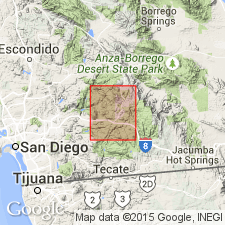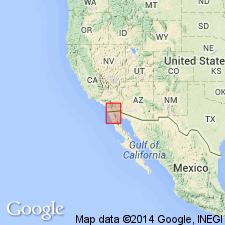
- Usage in publication:
-
- Woodson Mountain granodiorite*
- Modifications:
-
- Named
- Dominant lithology:
-
- Granodiorite
- AAPG geologic province:
-
- Peninsular Ranges province
Summary:
Named from its characteristic outcrops on Woodson Mountain, northeast of southeastern corner of San Luis Rey 30' quad and few mi southwest of Ramona. [Name credited to Miller (1937) who credited name to Prof. Larsen]. Rocks in part called Steele Valley granodiorite and Cajalco quartz monzonite by Dudley (1935). Woodson Mountain granodiorite is present in many large masses in western part of Peninsular Ranges, the largest underlies area of about 80 sq mi. In Corona, Elsinore, and San Luis Rey 30' quads, unit underlies about 220 sq mi. Is light-colored rather coarse-grained granodiorite that contains biotite and little hornblende. Intrudes Green Valley, Bonsall, and La Sierra tonalites, and Temescal Wash porphyry. Is older than Roblar leucogranite (new) and Mount Hole granodiorite. Age given as Cretaceous.
Source: GNU records (USGS DDS-6; Menlo GNULEX).

- Usage in publication:
-
- Woodson Mountain granodiorite*
- Modifications:
-
- Age modified
- Areal extent
- AAPG geologic province:
-
- Peninsular Ranges province
Summary:
Type locality designated as Woodson Mountain southwest corner of Ramona 15' quad, San Diego Co, Ca. Called Woodson granodiorite in Ramona 16' quad by Merriam (1946). 38 sq mi area of Woodson Mountain granodiorite is mapped in Cuyamaca Peak 15' quad where some of rocks formerly called Descanso granodiorite (W.J. Miller, 1935). Petrographic analysis included for samples from type locality and other areas. Hypersthene-bearing facies type is separately mapped. Age in Cuyamaca Peak 15' quad shown as Late Cretaceous.
Source: GNU records (USGS DDS-6; Menlo GNULEX).

- Usage in publication:
-
- Woodson Mountain granodiorite
- Modifications:
-
- Geochronologic dating
- AAPG geologic province:
-
- Peninsular Ranges province
Summary:
K-Ar ages on biotite from samples of Woodson Mountain granodiorite collected on Mount Woodson (32 deg 59'42"N, 116 deg 58'50"W) yielded about 104 Ma; sample collected near Mount Laguna (32 deg 57'57"N, 116 deg 30'32"W) yielded about 89 Ma.
Source: GNU records (USGS DDS-6; Menlo GNULEX).
For more information, please contact Nancy Stamm, Geologic Names Committee Secretary.
Asterisk (*) indicates published by U.S. Geological Survey authors.
"No current usage" (†) implies that a name has been abandoned or has fallen into disuse. Former usage and, if known, replacement name given in parentheses ( ).
Slash (/) indicates name conflicts with nomenclatural guidelines (CSN, 1933; ACSN, 1961, 1970; NACSN, 1983, 2005, 2021). May be explained within brackets ([ ]).

